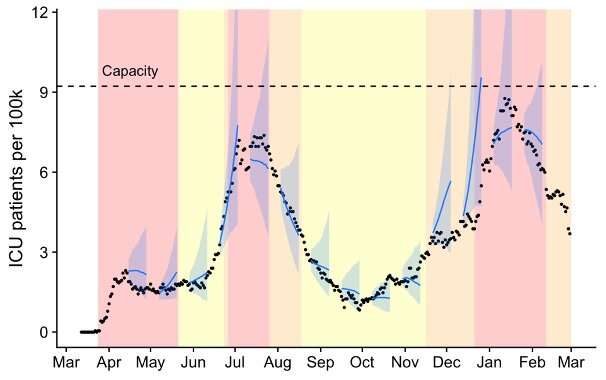Home » Health News »
COVID forecasting method using hospital and cellphone mobility data

Using cellphone mobility data and COVID-19 hospital admissions data, researchers at The University of Texas at Austin have reliably forecast regional hospital demands for almost two years, according to a new study published in the Proceedings of the National Academy of Sciences. The forecasting system, which municipal authorities credit with helping Austin maintain the lowest COVID-19 death rate among all large Texas cities, has been built out for use by 22 municipal areas in Texas and can be used by any city to guide COVID-19 responses as the virus continues to spread.
The scientific team—collaborating with Austin city elected leaders, public health officials and health care system executives—developed a powerful forecasting model and two public-facing dashboards that allowed city leaders to manage health care resources, ensure sufficient hospital capacity and communicate pandemic risks to the public.
When the model was developed in the first months of the pandemic, it stood out among other forecasts that were available online. For example, the UT model incorporated detailed public movement data and hospital admissions data long before the well-known Institute for Health Metrics and Evaluation (IHME) model by the University of Washington. The model also provides city-level rather than state-level forecasts that are vital for anticipating and managing COVID-19 health care surges. To do so, it incorporates detailed information about the ages and health risks of local residents.
The forecasting dashboards developed by the UT COVID-19 Modeling Consortium use intuitive graphics and spaghetti lines from hurricane forecasting to communicate the immediate and future risks of COVID-19. The daily online forecasts have been helping Austin residents and local officials make life-saving decisions since the spring of 2020. The model can be adapted to project COVID-19 health care needs in any U.S. city three weeks in advance. It uses anonymized cellphone mobility data from SafeGraph, which indicates how much time people stay at home and how frequently they visit points of interest such as bars, restaurants and schools. These data reflect how behaviors change daily in response to changing COVID-19 conditions.
“Community movement data helps us gauge changing COVID-19 transmission risks and anticipate health care surges several weeks in advance,” said Spencer Fox, corresponding author and associate director of the UT COVID-19 Modeling Consortium.
The team also measured the relationship between mobility and COVID-19 transmission and found that precautionary measures, such as face masks and social distancing, reduced the risks of transmission when people were out in public.
“The relationship between mobility and COVID-19 transmission was weaker in February 2021 compared to March 2020, suggesting that the community found safer ways to interact in public,” said Fox.
The researchers found a strong correlation between COVID-19 policies and pandemic trends. When behaviors relaxed, the virus picked up speed. When restrictions were enacted to curb surges, they had the desired effect. For example, Texas’ rapid reopening policy in the spring of 2020 corresponded with a major COVID-19 surge in Austin, which subsided after the implementation of local restrictions and a statewide mask mandate.
“This forecasting system helped save lives by allowing our community to see what they needed to do and when they needed to do it,” said Austin Mayor Steve Adler. “This tool stands at the intersection of science and public policy and shows the good that can be realized when they are aligned. It was an honor to be part of such a stellar team that developed and applied this system,” said Adler.
The forecasting system was developed by a municipal COVID-19 task force in Austin that included scientists, civic leaders, public health officials and health care executives. The model projections have informed policy decisions and response actions throughout the pandemic, including resource planning by local hospitals, requests for additional resources from state and federal agencies, the launch and dismantling of alternative care sites to provide additional health care capacity, and changes in the Austin-area COVID-19 alert stage to communicate and manage risks. The model projections have been frequently discussed in public forums and highlighted by news media.
Data-driven policies and effective health messaging have helped Austin to keep its COVID-19 death rate the lowest among all large Texas cities.
Source: Read Full Article



